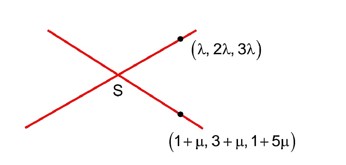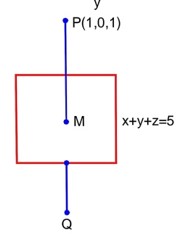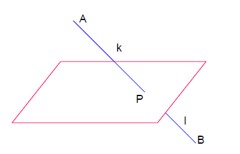Three Dimensional Geometry
Get insights from 212 questions on Three Dimensional Geometry, answered by students, alumni, and experts. You may also ask and answer any question you like about Three Dimensional Geometry
Follow Ask QuestionQuestions
Discussions
Active Users
Followers
New answer posted
2 months agoContributor-Level 10
For point of intersection
1 + 3λ = 3 + μ
2 + λ = 1 + 2μ
5λ = 5 ⇒ λ = 1, μ = 1
Point of intersection (4, 3, 5)
For the greatest distance from origin perpendicular from meet plane at point of intersection
Hence equation r . (4i + 3j + 5k) = 50
New answer posted
2 months agoContributor-Level 9

7x – 2y – z + d = 0
(2, 4, 6) Þ d = -14 + 8 + 6
d = 0
7x – 2y – z = 0
7 – 2 = 5
New answer posted
2 months agoNew answer posted
2 months agoContributor-Level 10
Let direction ratio of the normal to the required plane are l, m, n
Equation of required plane
11 (x – 1) + 1 (y – 2) + 17 (z + 3) = 0
New answer posted
2 months agoContributor-Level 10
Any point on line
5r + 12 = 17
r = 1
New answer posted
2 months agoContributor-Level 10
| 1 -1 -1 |
| 1 -k | = 0
| k 2 1 |
⇒ 1 (1 + 2k) + 1 (1 + k²) – 1 (2 – k) = 0
2k + 1 + 1 + k² − 2 + k = 0
k² + 3k = 0
k = 0, -3
New answer posted
2 months agoContributor-Level 10
(x-a)/3 = (y-b)/ (-4) = (z-c)/12 = -2 (3a-4b+12c+19)/ (3²+ (-4)²+12²)
(x-a)/3 = (y-b)/ (-4) = (z-c)/12 = (-6a+8b-24c-38)/169
(x, y, z) = (a–6, β, γ)
(a-b)-a)/3 = (β-b)/ (-4) = (γ-c)/12 = (-6a+8b-24c-38)/169
(β-b)/ (-4) = -2
=> β = 8+b
=> 3a – 4b + 12c = 150 . (i)
a + b + c = 5
=> 3a + 3b + 3c = 15 . (ii)
Applying (i) – (ii), we get :
= 56 + 216 + 7b – 9c = 56 + 216 – 135 = 137
New answer posted
2 months agoContributor-Level 10
l + m – n = 0 => n = l + m
3l² + m² + cnl = 0
3l² + m² + cl (l+m) = 0
= (3+c) (l/m)² + c (l/m) + 1 = 0
? Lines are parallel
D = 0
c = 4 (as c > 0)
New answer posted
2 months agoContributor-Level 10
P will be the centroid of triangle ABC.
The centroid P is (x? +x? +x? )/3, (y? +y? +y? )/3).
The coordinates of P are given as (17/6, 8/3).
The coordinates of Q are not given, but a calculation is shown.
PQ = √ (24/6)² + (9/3)²) = √ (4² + 3²) = √ (16+9) = √25 = 5.
This implies the coordinates of Q are such that the difference in coordinates with P leads to this result. For example if P= (x? , y? ) and Q= (x? , y? ), then x? -x? =4 and y? -y? =3.
Taking an Exam? Selecting a College?
Get authentic answers from experts, students and alumni that you won't find anywhere else
Sign Up on ShikshaOn Shiksha, get access to
- 65k Colleges
- 1.2k Exams
- 679k Reviews
- 1800k Answers


